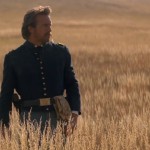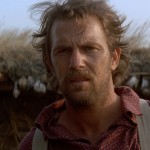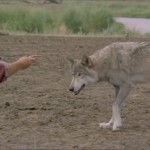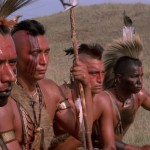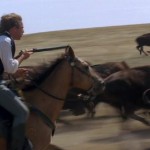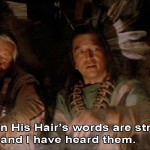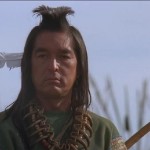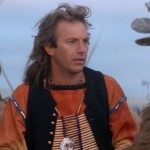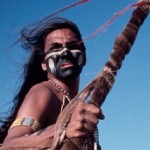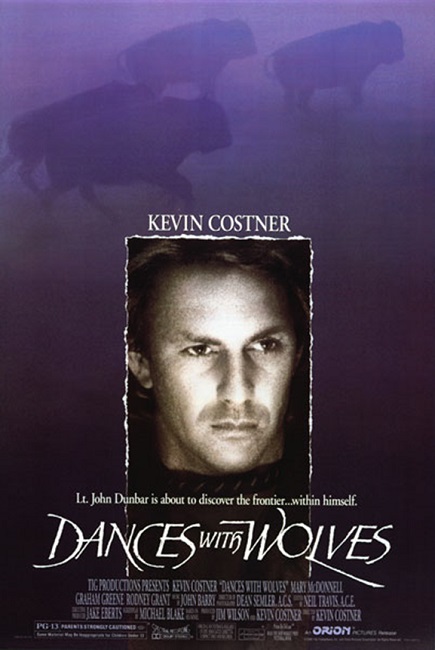
Dances With Wolves – 1990
I have been looking forward to seeing this Best Picture winner for a very long time. It is a movie that I have wanted to see for years. But now that I have seen it, I find myself a little disappointed, though only a little. This is in no way the movie’s fault. I had built it up in my mind to be a phenomenal film, so much so that reality could never measure up to my expectations. In reality, it was a very good movie – there is no denying that. I just need to let go of the unrealistic fantasy I had envisioned it to be.
This was Kevin Costner’s directorial debut, for which he won an Oscar. The attention to detail and the high production values were incredible. Many of the actors including Costner and Mary McDonnell had to learn to speak in the Lakota Sioux language. Doris Leader Charge, the actress playing the part of Pretty Shield was actually the dialogue coach for the production.
Interesting note: The original book on which the film is based had used Comanche Indians, but my research sources gave two different reasons as to why this was changed to the Sioux for the film. One source claimed that the change was due to the availability of native Sioux speakers. The other source said that because of the importance of the buffalo to the plot the Sioux were used because they used to live near the biggest buffalo heard in the country.
Costner did a good job playing the part of John Dunbar, a soldier in the Union Army during the Civil War. He is first seen lying on a table, badly wounded as the doctors discuss amputating his foot. Instead, he runs away and tries to commit suicide by finding a battlefield, getting on a horse and charging the enemy lines alone. Fortunately he avoids being shot and inadvertently gives the Union Soldiers the opportunity to win the battle. As a reward, he is given proper care for his foot, the horse he had stolen to do his brave deed, and the choice of any post he wanted.
He chooses the western frontier, wanting to see it before it is gone. Through a series of unfortunate circumstances, he arrives at Fort Sedgwick, an abandoned post, and nobody knows or has any record that he is there. To make a long story short, he meets the Lakota Sioux Indians and befriends them, and this is really where the heart of the movie begins. This is what we have all come to see: the Indians. We learn how he becomes a member of their tribe, how he learns their language and customs, how he gets the name Dances With Wolves, and what happens when the rest of the white men finally do arrive.
Costner, as an actor, really did a good job, and of course, carried the lion’s share of the movie. The plot was told from Dunbar’s point of view, so Costner was in nearly every scene, which is saying a lot for a movie that was just under 4 hours long.
But honestly, I have always seen Costner as just a passable actor, though nothing I would call great. This film just reinforced that opinion. He always has a kind of natural calmness and, for lack of a better term, sleepiness about him that unfortunately often translates on the big screen as just low-energy. Obviously, he knows his lines and can run fast when he needs to, but I still found his performance a bit lack-luster.
Playing opposite Costner as the female romantic lead was Mary McDonnell. Her character’s name was Stands With a Fist. Like all Indian names for the Lakota tribe, hers was given to her and had a very personal meaning. Her story is interesting enough to mention here. She was the adopted daughter of Kicking Bird, the social and spiritual leader of the tribe, her parents having been slaughtered by the Sioux’s enemies, the Pawnee Indians. As a young girl, an older woman of the tribe would constantly call her names and beat her until one day she stood up and fought back. With one punch, she knocked the older woman out, thereby earning her name.
McDonnell did a fantastic job. She was integral to Dunbar’s integration into the tribe, as Stands With a Fist remembered a smattering of the English language from her early childhood. McDonnell turned in a very convincing portrayal of someone who is trying to remember a language in that way. The way she pronounced certain words, or the fact that some of her word inflections were just a little bit off made for a very realistic character. Well done McDonnell.
Among the Indians, there were a number of very good actors. Graham Green played the part of Kicking Bird, Dunbar’s main advocate among the Lakota tribe. He was a bit of a screen-stealer. When he spoke, his words always seemed to have weight and importance. Kicking Bird was a man of gentleness and wisdom, of quiet bravery and great honor. He was the kind of man anyone would want to know.
While Kicking Bird was the social and spiritual leader of the tribe, Wind in His Hair, played by Rodney A. Grant, was the military leader. I thought he also did an exceptional job. His character went through the biggest change of all, going from a position of great distrust of the white Dunbar, to becoming his greatest friend; who, when Dunbar was leaving the tribe at the end, stood on a bluff and shouted for all the tribe to hear, “Dances With Wolves! I am Wind In His Hair. Do you see that I am your friend? Can you see that you will always be my friend?” That was a very emotional scene.
Another honorable mention was Floyd Red Crow Westerman, playing the Lakota Indian Chief, Chief Ten Bears. He was the oldest and wisest of the Indians, often giving the most sage advice to Dances With Wolves. He did a good job, and I think I remember reading somewhere that he was the only member of the cast who was actually a native speaker of the Lakota Sioux language.
One of the iconic scenes in the movie was the great buffalo hunt. Taking over 8 days to film, it was a pretty intense and complicated sequence. It is important to note that this was done in the days when CGI was still in its infancy. There were no computer generated buffalo, though there were a few animatronic ones. This was a great scene which really drew you into the story. The buffalo were a very important part of the lives of the Plains Indians. In fact, the Sioux were also known as the Buffalo Tribe. The entire scene was done with a sort of reverence and joy that came across quite clearly. It was inspirational.
Interesting note: During the filming of the scene where a buffalo is charging at the young Indian Smiles a Lot, the buffalo was actually charging at a pile of its favorite treat: Oreo cookies.
A really great part of this movie was the soundtrack. Composer John Barry wrote what many consider to be one of the greatest film scores of all time. I know it is one of my personal favorites. John Barry also wrote the film score, and earned an Oscar for the previous Best Picture winner Out of Africa in 1985. He won the Best Original Score Academy Award for the Dances With Wolves soundtrack as well.
Interesting note: Pope John Paul II once mentioned that the soundtrack for Dances With Wolves was one of his favorite pieces of music.
One of the reasons that the soundtrack was so effective brings me to another wonderful aspect of the film: the cinematography. In a word, it was incredible. Cinematographer Dean Semler must have been given free reign when it came to getting shots of wide open country, nature scenes that would put most nature documentaries to shame, bright and brilliant sunrises, lush and vibrant sunsets, and everything in-between. Of course, Semler took home an Oscar for his work.
And finally, I have to mention that as tragic as the story ended, with Dances With Wolves and Stands With a Fist having to leave the tribe, I have to mention that the plot could have taken a much worse turn. Everyone knows that the American Indians were, historically, treated abominably. Most of them did not want a fight. They just wanted to be left alone in peace. The white man’s treatment of this country’s original inhabitants is a shameful part of our past. Costner and those who worked on this film with him portrayed the Indians in such a positive light, especially compared to the white men of the time. It was the Union soldiers who were depicted as the bad guys, and the Indians as the good guys. In fact, because the film was so uniquely positive towards Native Americans, the Sioux Nation adopted Costner as an honorary member.
Interesting note: This film was obviously a labor of love for Costner. The original budget for the movie was $15 million, but because of the high production values, the cost ended up going over $18 million. The extra $3 million was provided by Costner himself. Because of the film’s success, Costner reportedly took in over $40 million from his original investment.
If I had anything negative to say about the movie (aside from Costner‘s acting), it would be its length. Four hours is a long time to sit through a movie, and from what I have heard, there was even more footage that did not make it into the film. But the trick is that I can’t think of very much that I would have taken out. Everything seemed to be necessary for the in-depth character development and the realism of the plot. Not only did Costner know what he was doing in the director‘s chair, he stuck to his guns and eventually got the film he wanted.
In saying that, I have to explain that the original theatrical release was only about three hours long, but I watched the director’s cut. In general, I think that most movies should be seen that way with everything kept in that the director intended. It usually makes for a better film. And Dances With Wolves certainly was a good film that was well worth watching.
